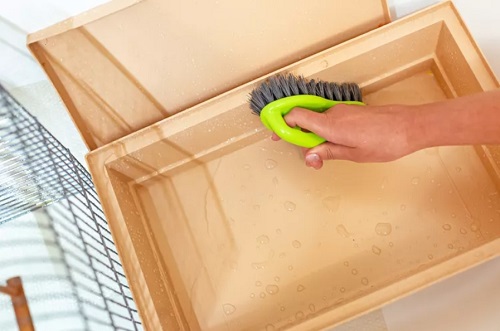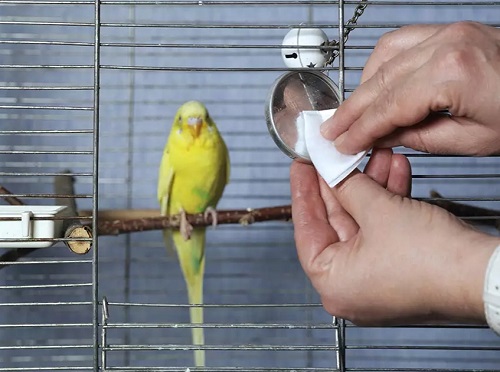Cleaning a bird cage is not just about keeping things tidy; it’s essential for the health and well-being of your bird. A dirty cage can harbor bacteria, mold, and parasites, which can lead to serious health issues. By learning how to clean a bird cage properly, you can ensure your feathered friend lives in a safe and hygienic environment. This article will guide you through the best practices, from gathering the necessary tools to executing a thorough cleaning routine. Whether you’re a seasoned bird owner or new to the world of avian care, these tips will help you maintain a spotless and healthy bird cage.

What Are the Essential Tools for Cleaning a Bird Cage?
To clean a bird cage efficiently, having the right tools is crucial. The basic tools include a stiff brush, a scraper for removing stuck-on debris, paper towels, and a bird-safe disinfectant. Additionally, a handheld vacuum or broom is useful for collecting fallen seeds, feathers, and dust. For cleaning the cage accessories, such as perches and toys, a scrub brush and mild soap are necessary. It’s important to use tools that are dedicated to your bird’s cage only to avoid cross-contamination. By keeping these tools handy, you can streamline your cleaning process and ensure that the cage remains a safe place for your bird.
Step-by-Step Guide: How to Clean a Bird Cage
Removing and Cleaning Cage Accessories
Begin the cleaning process by removing all accessories from the bird cage, including perches, toys, and feeding dishes. Soak these items in warm, soapy water to loosen any dirt, droppings, or food residue. Use a scrub brush to thoroughly clean each item, ensuring that you reach all the nooks and crannies where bacteria can hide. Rinse everything with clean water to remove soap residue, then allow the items to dry completely before placing them back in the cage. Regularly cleaning the accessories not only keeps them looking good but also helps prevent the spread of disease.

Disinfecting the Cage Safely
Disinfecting the bird cage is an essential step in eliminating harmful bacteria and pathogens. After removing the accessories, use a bird-safe disinfectant on all cage surfaces. Pay special attention to the bars, corners, and bottom tray, as these areas tend to accumulate the most dirt and waste. Allow the disinfectant to sit for the recommended amount of time to ensure it kills all germs. Once the disinfection process is complete, rinse the cage thoroughly with water to remove any chemical residue. Dry the cage completely before reassembling it, as moisture can promote bacterial growth and create an unhealthy environment for your bird.
Replacing the Cage Lining
The cage lining is where most of the waste accumulates, so it’s crucial to replace it regularly. After cleaning and disinfecting the cage, place a fresh layer of newspaper, paper towels, or a commercial bird cage liner at the bottom. This lining should be easy to remove and replace, allowing you to maintain cleanliness with minimal effort. For added convenience, consider using a double-layer system, where you remove the top layer daily and leave the bottom layer for weekly deep cleanings. This approach helps control odors and keeps the cage looking neat between thorough cleanings.
How Often Should You Clean a Bird Cage?
The frequency of cleaning a bird cage depends on several factors, including the size of the cage, the number of birds, and their habits. As a general rule, you should perform a light cleaning every day, which involves removing waste, replacing the cage lining, and wiping down any dirty spots. A more thorough cleaning, including washing the cage and its accessories, should be done weekly. Larger cages or those housing multiple birds may require more frequent cleanings. By establishing a regular cleaning schedule, you can prevent the buildup of harmful bacteria and ensure a healthy environment for your bird.
Tips to Maintain a Clean Bird Cage
Maintaining a clean bird cage between deep cleanings can make your weekly tasks easier and keep your bird healthier. One effective tip is to place food and water dishes in areas that are easy to access and clean, reducing the likelihood of spills and messes. Additionally, using cage liners that can be quickly replaced helps manage waste without requiring daily deep cleanings. Regularly rotating and cleaning toys and perches will also prevent bacteria buildup. By staying on top of small tasks, you can keep the cage clean with minimal effort, ensuring that your bird’s living space remains a safe and comfortable home.
Conclusion
Cleaning a bird cage is a crucial part of responsible bird ownership. By following these best practices on how to clean a bird cage, you can create a safe and healthy environment for your feathered friend. Regular cleaning not only prevents the spread of disease but also makes your bird more comfortable in its home. With the right tools and a consistent routine, keeping your bird cage clean becomes an easy and rewarding task. Remember, a clean cage is key to a happy and healthy bird, so make it a priority in your bird care routine.
FAQ:
1.How do I clean a bird cage without harming my bird?
To clean a bird cage without harming your bird, use bird-safe cleaning products and make sure to rinse the cage thoroughly to remove any residue. Always remove your bird from the cage before cleaning to prevent exposure to chemicals or wet surfaces. Allow the cage to dry completely before reintroducing your bird.
2.What cleaning products are safe for bird cages?
Safe cleaning products for bird cages include mild dish soap, diluted vinegar, and bird-safe disinfectants specifically designed for use with avian habitats. Avoid harsh chemicals like bleach or ammonia, which can be toxic to birds. Always check the labels and use products that are labeled as safe for birds.
3.How can I reduce the frequency of deep cleaning?
To reduce the frequency of deep cleaning, perform daily maintenance such as spot cleaning, replacing soiled cage liners, and wiping down dirty spots. Using removable tray liners and organizing the feeding area to minimize spills can also help keep the cage cleaner for longer periods. Regular maintenance prevents buildup, reducing the need for frequent deep cleanings.
